How to Manage Buying Power Risk in Small Option Accounts

How to Manage Buying Power Risk in Small Option Accounts
By:Kai Zeng
Three management techniques help us traders control naked options effectively in small accounts
- Buying Power Expansion is a critical risk that tastybite traders should monitor closely. BPR spikes can significantly increase the risk in small accounts.
- To reduce buying power impact, focus on lower-priced underlyings for higher premium-to-BPR ratios. That improves capital efficiency and creates trading opportunities.
- Higher IV Rank offesr reduced BPR at equivalent stock prices.
Small-account traders face specific challenges when selling naked options, including naked puts, calls, strangles, jade lizards or any combination with naked positions.
One challenge is the higher buying power requirement (BPR). Naked options require much greater BPR than risk-defined strategies, which can restrain the use of capital.
Another challenge comes with volatile BPR, which fluctuates with naked options. Potential BPR expansion can significantly increase the percentage of capital allocation.
This time, let’s focus on how BPR changes and affects a portfolio when the following criteria change: underlying price levels, underlying price movement or the level of implied volatility. Here are some considerations.
1. Focus on Lower-priced Stocks
Not only do high-priced stocks require significantly more BPR to start with, but also their premium-to-BPR ratios might not be as good as some cheaper alternatives. To trade naked options effectively, these low-priced stocks can help keep our capital use in a healthy range.
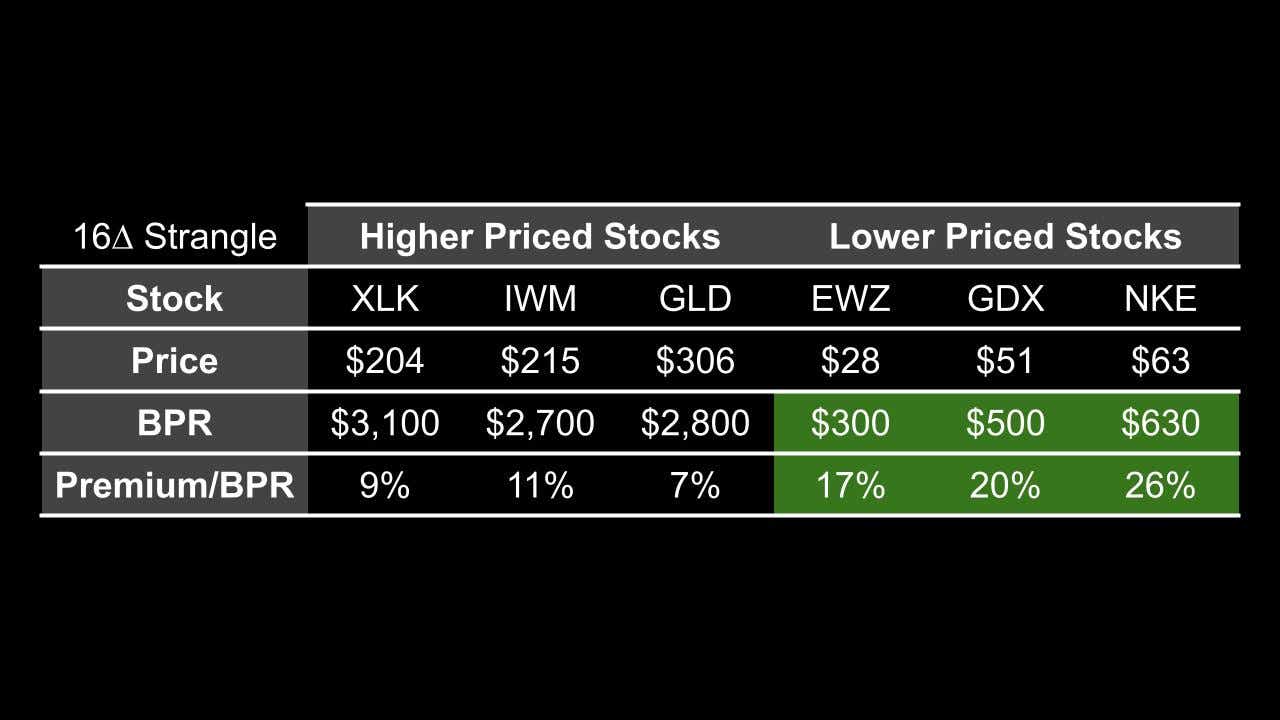
2. A quick stock price change that moves closer to the strikes can increase BPR
This affects our capital allocation. A large move in IWM, such as 15%, can increase an existing position's BPR by more than 200% from the initial order entry. If IV increases at the same time, the BPR expansion can be even higher.
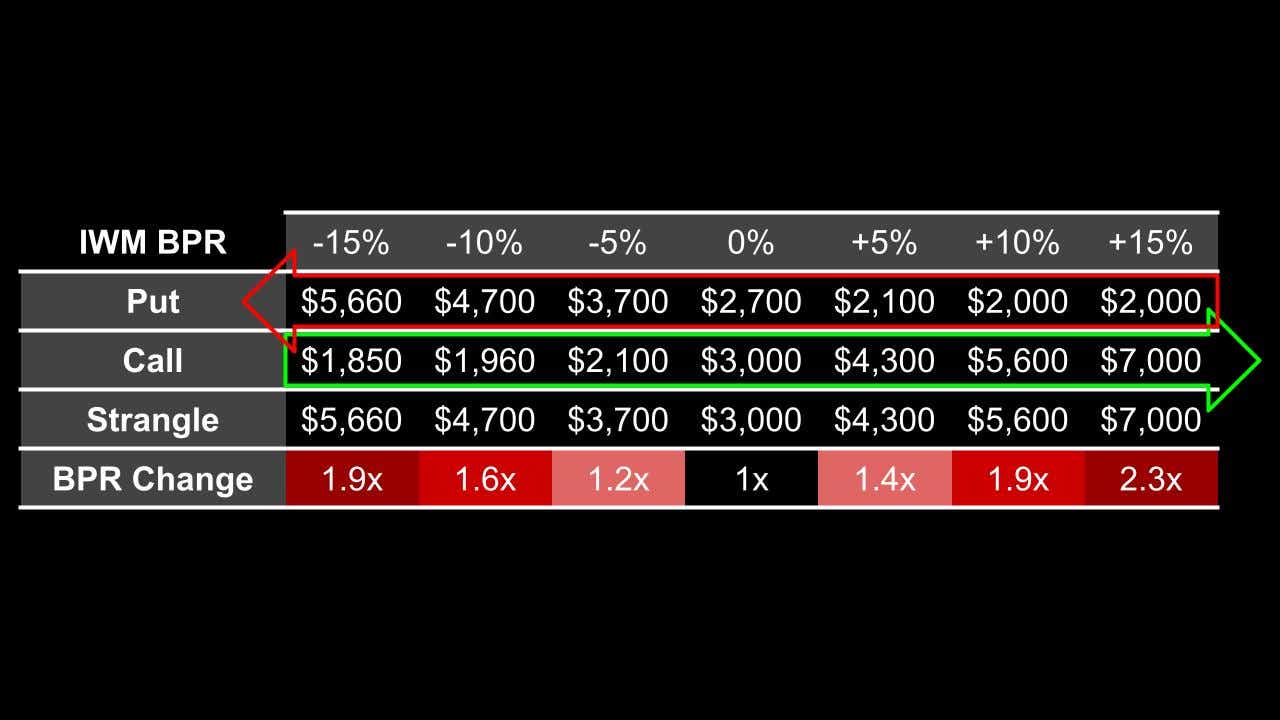
Here are some of the largest moves in the S&P 500 and the 1SD strangle's BPR changes in the past two decades. Two observations: First, large stock price swings toward or exceeding the strikes can quickly increase BPR. Second, for similar magnitude moves, BPR expands even faster on the way up than during pullbacks.
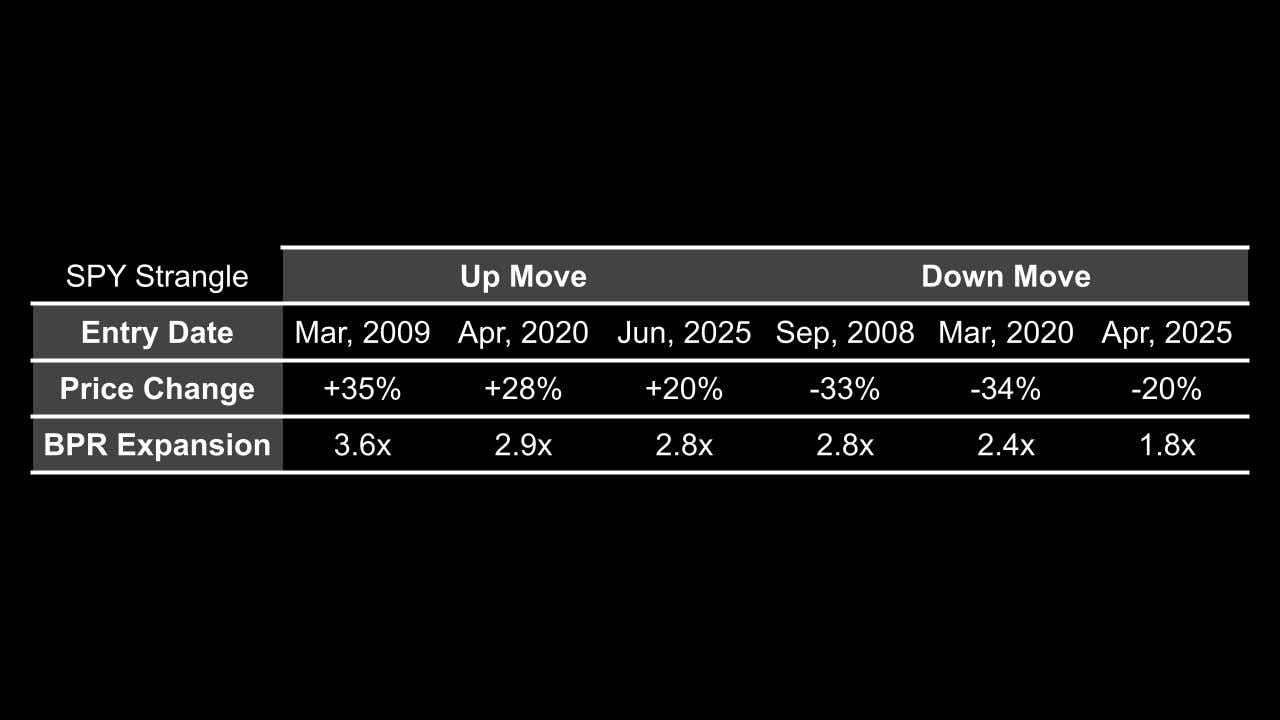
The worst-case scenario is 3.6x more BPR than at order entry. It means that if we deployed 30% of the capital in a $20,000 account at order entry, it would end up using all of the available capital quickly unless it’s managed carefully. That's why holding positions for too long usually causes performance to deteriorate. Early management can reduce tail risks from large market moves.
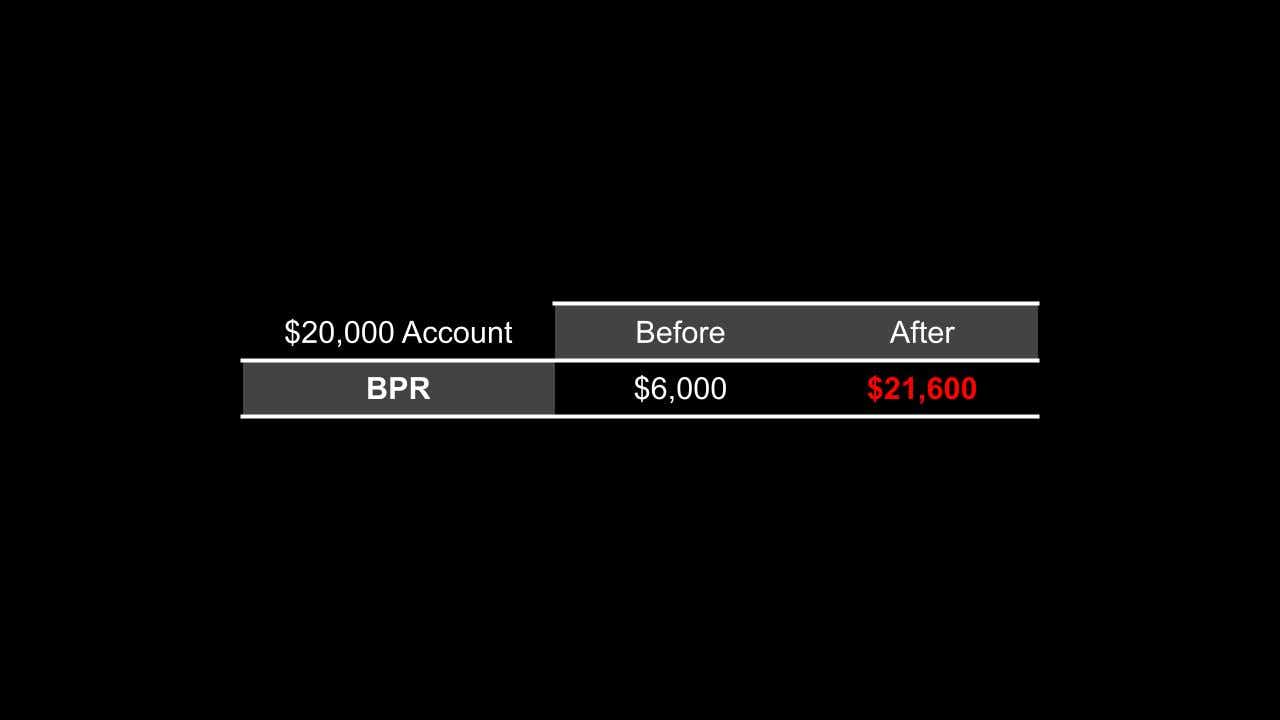
3. High IV Rank can help reduce BPR at the same stock price levels
This improves capital efficiency. The Nike example demonstrates how high IV Rank reduced BPR by 23%, compared to low IV environments.
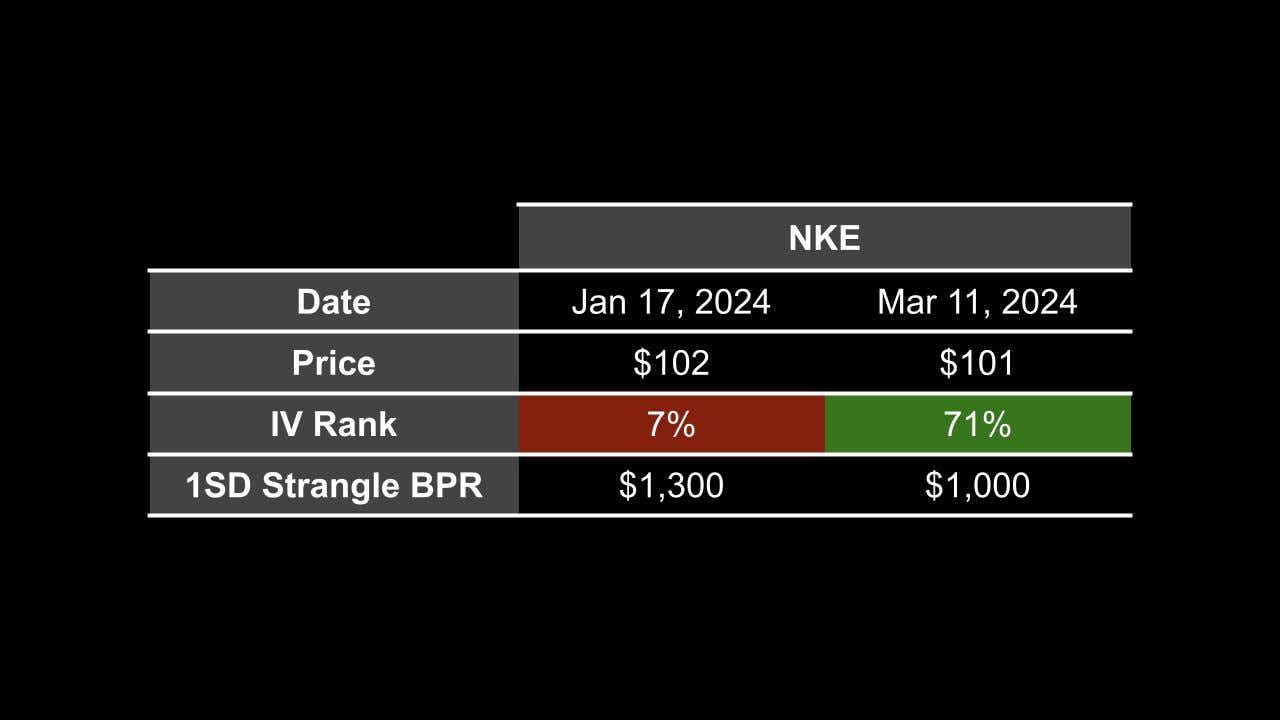
Mastering these three BPR management techniques will help us trade naked options more effectively in small accounts while maintaining proper capital allocation throughout different market conditions.
Kai Zeng, director of the research team and head of Chinese content at tastylive, has 20 years of experience in markets and derivatives trading. He cohosts several live shows, including From Theory to Practice and Building Blocks. @kai_zeng1
For live daily programming, market news and commentary, visit tastylive or the YouTube channels tastylive (for options traders), and tastyliveTrending for stocks, futures, forex & macro.
Trade with a better broker, open a tastytrade account today. tastylive, Inc. and tastytrade, Inc. are separate but affiliated companies.
Options involve risk and are not suitable for all investors. Please read Characteristics and Risks of Standardized Options before deciding to invest in options.
tastylive content is created, produced, and provided solely by tastylive, Inc. (“tastylive”) and is for informational and educational purposes only. It is not, nor is it intended to be, trading or investment advice or a recommendation that any security, futures contract, digital asset, other product, transaction, or investment strategy is suitable for any person. Trading securities, futures products, and digital assets involve risk and may result in a loss greater than the original amount invested. tastylive, through its content, financial programming or otherwise, does not provide investment or financial advice or make investment recommendations. Investment information provided may not be appropriate for all investors and is provided without respect to individual investor financial sophistication, financial situation, investing time horizon or risk tolerance. tastylive is not in the business of transacting securities trades, nor does it direct client commodity accounts or give commodity trading advice tailored to any particular client’s situation or investment objectives. Supporting documentation for any claims (including claims made on behalf of options programs), comparisons, statistics, or other technical data, if applicable, will be supplied upon request. tastylive is not a licensed financial adviser, registered investment adviser, or a registered broker-dealer. Options, futures, and futures options are not suitable for all investors. Prior to trading securities, options, futures, or futures options, please read the applicable risk disclosures, including, but not limited to, the Characteristics and Risks of Standardized Options Disclosure and the Futures and Exchange-Traded Options Risk Disclosure found on tastytrade.com/disclosures.
tastytrade, Inc. ("tastytrade”) is a registered broker-dealer and member of FINRA, NFA, and SIPC. tastytrade was previously known as tastyworks, Inc. (“tastyworks”). tastytrade offers self-directed brokerage accounts to its customers. tastytrade does not give financial or trading advice, nor does it make investment recommendations. You alone are responsible for making your investment and trading decisions and for evaluating the merits and risks associated with the use of tastytrade’s systems, services or products. tastytrade is a wholly-owned subsidiary of tastylive, Inc.
tastytrade has entered into a Marketing Agreement with tastylive (“Marketing Agent”) whereby tastytrade pays compensation to Marketing Agent to recommend tastytrade’s brokerage services. The existence of this Marketing Agreement should not be deemed as an endorsement or recommendation of Marketing Agent by tastytrade. tastytrade and Marketing Agent are separate entities with their own products and services. tastylive is the parent company of tastytrade.
tastyfx, LLC (“tastyfx”) is a Commodity Futures Trading Commission (“CFTC”) registered Retail Foreign Exchange Dealer (RFED) and Introducing Broker (IB) and Forex Dealer Member (FDM) of the National Futures Association (“NFA”) (NFA ID 0509630). Leveraged trading in foreign currency or off-exchange products on margin carries significant risk and may not be suitable for all investors. We advise you to carefully consider whether trading is appropriate for you based on your personal circumstances as you may lose more than you invest.
tastycrypto is provided solely by tasty Software Solutions, LLC. tasty Software Solutions, LLC is a separate but affiliate company of tastylive, Inc. Neither tastylive nor any of its affiliates are responsible for the products or services provided by tasty Software Solutions, LLC. Cryptocurrency trading is not suitable for all investors due to the number of risks involved. The value of any cryptocurrency, including digital assets pegged to fiat currency, commodities, or any other asset, may go to zero.
© copyright 2013 - 2025 tastylive, Inc. All Rights Reserved. Applicable portions of the Terms of Use on tastylive.com apply. Reproduction, adaptation, distribution, public display, exhibition for profit, or storage in any electronic storage media in whole or in part is prohibited under penalty of law, provided that you may download tastylive’s podcasts as necessary to view for personal use. tastylive was previously known as tastytrade, Inc. tastylive is a trademark/servicemark owned by tastylive, Inc.